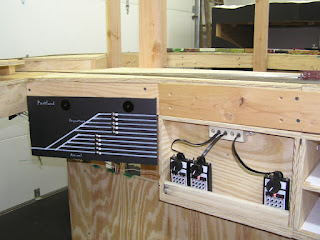Back in September I had the Oakridge section and east side of the pass all prepared for scenery, and was making slow headway with minor plaster filling and re-contouring in that area. Was just starting to work on the base color coats and geared up to add ground cover when I got transferred to another job...
I had to pull up all the masking tape off the rails when I found that it would be awhile until I had time to push further forward, and so the layout has basically sat idle since then. Otherwise, I have been purchasing a few items here and there and doing minor tinkering.
I bagged a CMX track cleaning car on ebay for 40% off, that is ready for its first test run...
Hopefully keeping it filled with cleaning solution will help with the track cleaning train, as chasing it around with an alcohol filled eye dropper was not the most efficient. I have found that 70% alcohol on my Centerline cleaner cars seems to build up a residue on loco wheels and other, but not sure what is actually taking place there. On-line reading tends me to think that the alcohol is partially breaking down the gunk and relocating it. My Minitrix wheel cleaner was balking at removing this gunk from engine wheels, and the only thing that would remove it was running each loco in place over an alcohol soaked tissue. So not sure what the best cleaning solution should be for the new CMX tanker... Some reading indicates use of lacquer thinner might be better, or perhaps 90% alcohol instead. My fear is in the weathered rail profile that I have painted with lacquer base paint, and how durable it will be with these solutions over the long haul. Since I can control the drip rate on the CMX car, I am leaning toward the laquer thinner and see how that goes.
Another acquisition I made on ebay was to get the 70 tonner needed for my Klamath Northern roster, which will be used between the KN interchange and the mill up at Gilchrist. I couldnt resist the 70% off price on this puppy. It needs the twin sealed beam and one of a kind door louvers, but pretty straight forward after that with the reefer orange paint and some custom decals.
Bachmann's version pulls fairly well on the flats, but after some extensive testing on similar grades and curves needed for this operation, I found that it will be most reliable pulling about five cars from Gilchrist Jct and up to the mill. It pulls seven on similar trackage here with minor wheel slip, but I should probably configure mill ops based on what appears will be the more reliable train length. This operation ran a couple trains per day anyhow, so might be a kick if that fits into the operating scheme here once we progress to that point.
Here is a shot of KN's later GE 125 tonner with a shorter cut of cars, coming back from the mill (another one of John Bauer's fine shots):
Adding cars to be used for the last lumber drag that will eventually fill the train schedule. Recently picked up a couple more Exact Rail out of production lumber boxcars with the yellow doors, and an old Columbia Cowlitz high cube box from LBF. I have a couple units acquired for this train so far, but still need to find a couple more Kato SD45s, then put decoders in them all.
Last few weeks been acquiring some screen mesh, and sifting old plaster bits and pieces for some loose rock / talus on the east side of the pass. Today I stained some sample runs of different earth colors... so see how they came out tomorrow, then can adjust as needed. This should get my scenery materials closer to complete for what is needed to finish the east side of the Hill (and possible upgrades to the west side later). More later...
Top of the list as soon as I see stability in the work schedule will be to call crews back from furlough. Look forward to more good times moving some traffic across the RR, and hopefully then we can also verify that the latest operating scheme has been fine tuned correctly.
Happy Holidays























